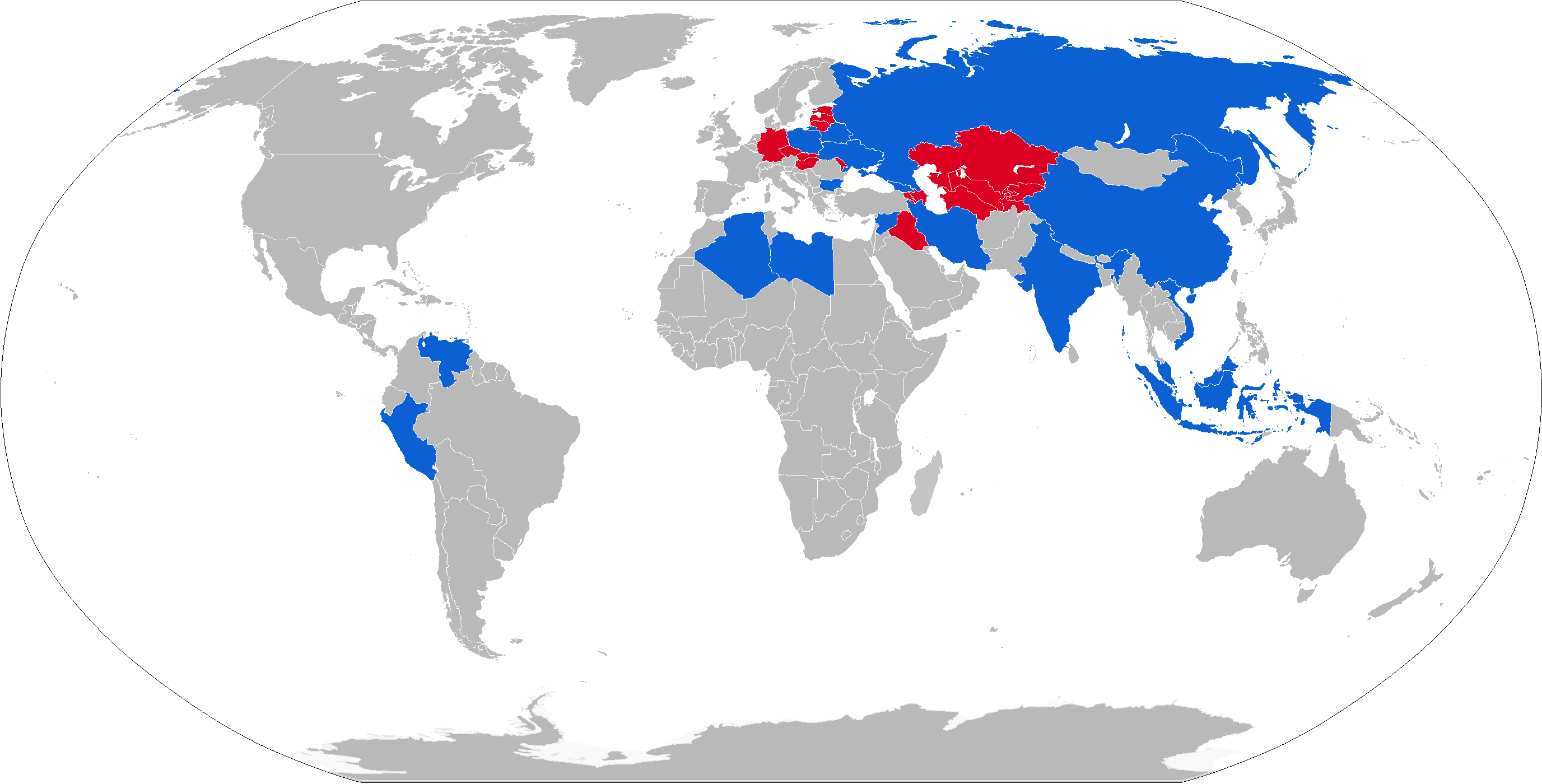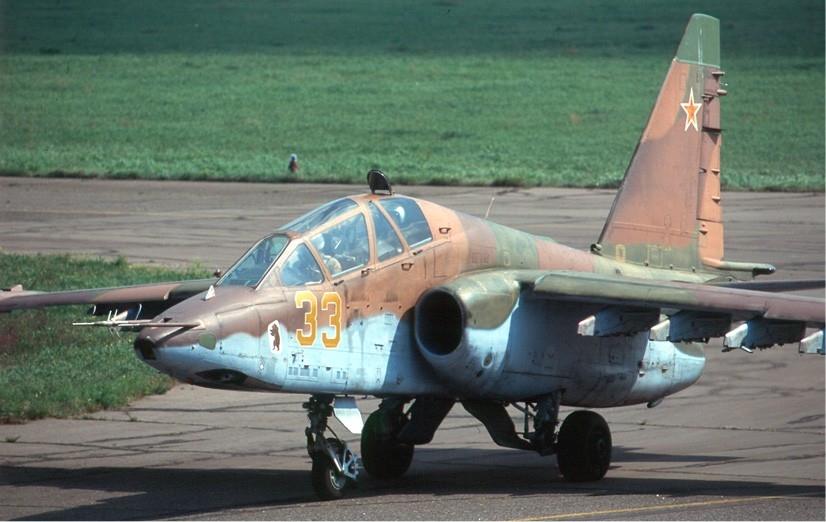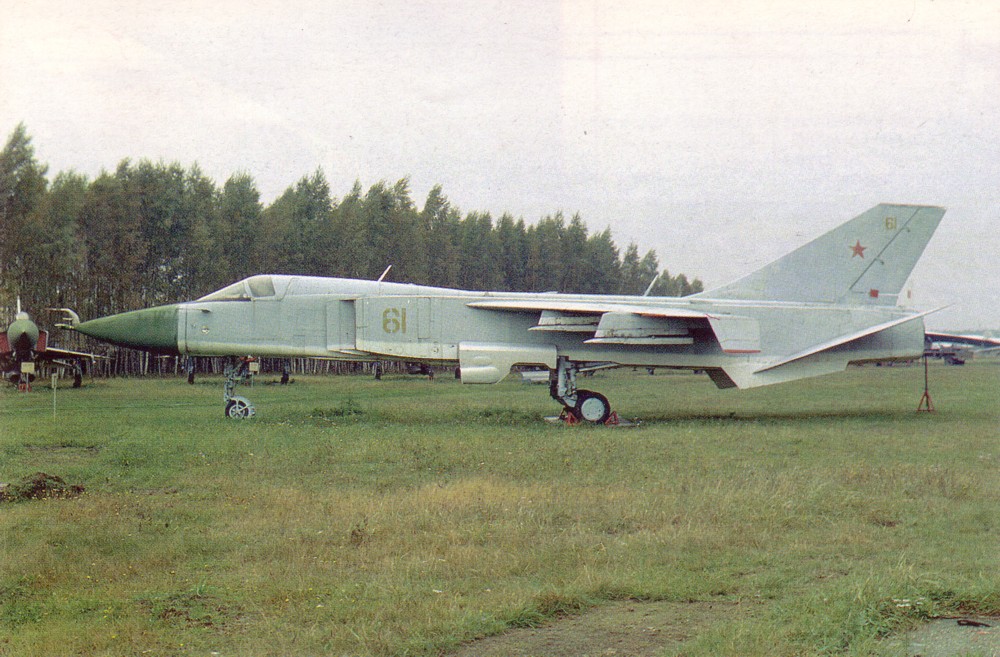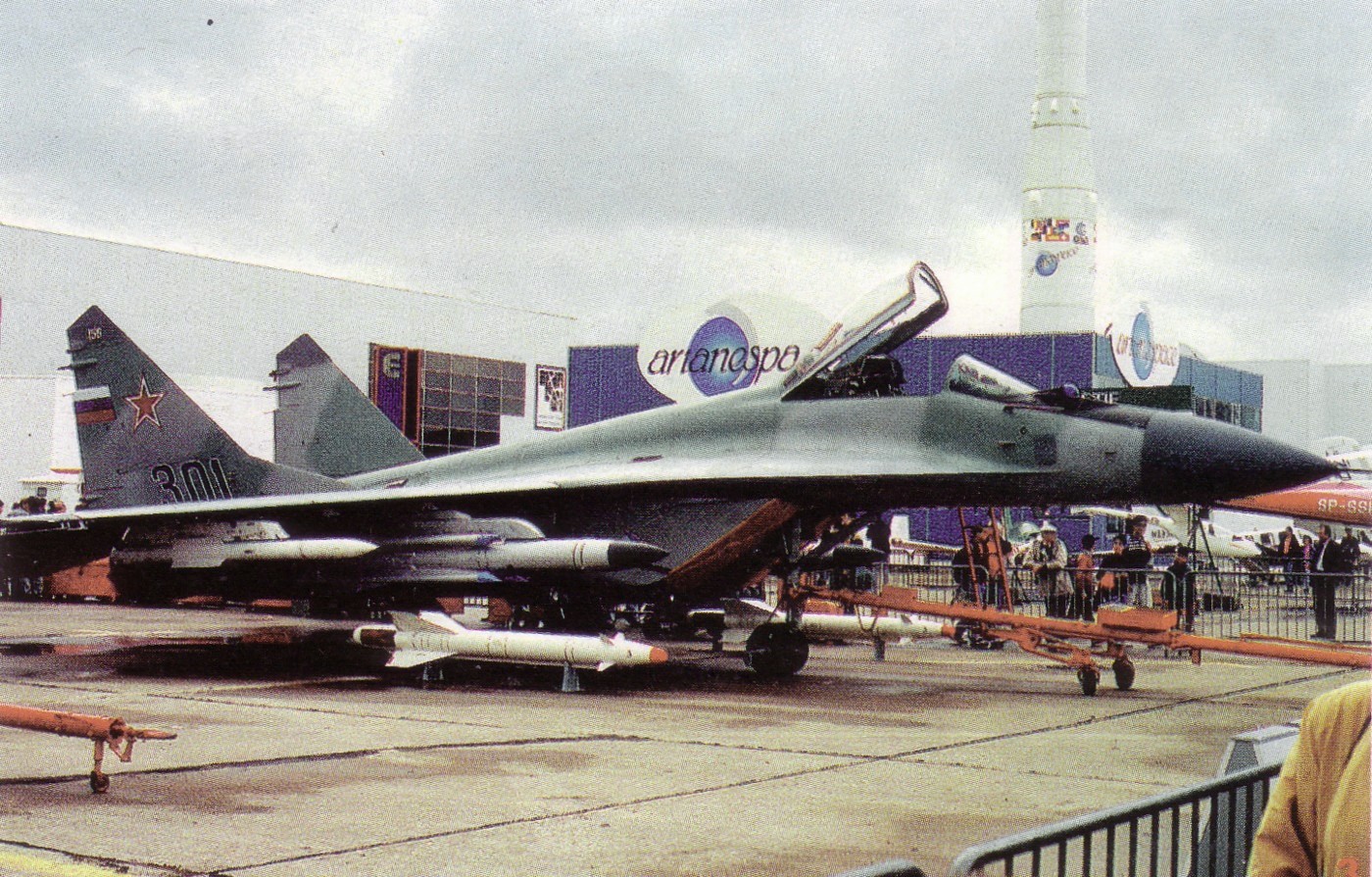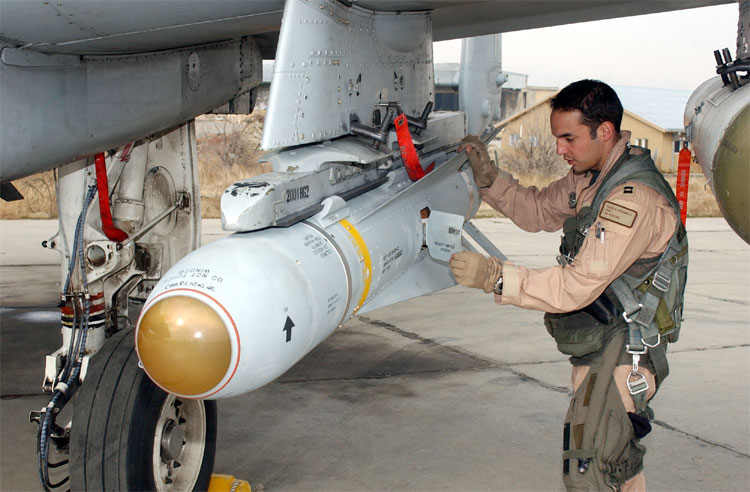|
Kh-29
The Kh-29 (; NATO: AS-14 'Kedge; GRAU: 9M721) is a Soviet air-to-surface missile with a range of 10–30 km. It has a large warhead of 320 kg, has a choice of laser, infrared, active radar or TV guidance, and is typically carried by tactical aircraft such as the Su-24, Su-30, MiG-29K as well as the Su-25, giving these aircraft an expanded standoff capability. The Kh-29 is intended for primary use against larger battlefield targets and infrastructure such as industrial buildings, depots and bridges, but can also be used against ships up to 10,000 tonnes, hardened aircraft shelters and concrete runways. Development Design started in the late 1970s at the Molniya design bureau in Ukrainian SSR on what would be their only air-to-ground munition, but when they moved exclusively to space work Vympel took over development of the Kh-29. The first firing of the missile took place in 1976 and after extensive trials the Kh-29 was accepted into service in 1980. Design The b ... [...More Info...] [...Related Items...] OR: [Wikipedia] [Google] [Baidu] |
Sukhoi Su-17
The Sukhoi Su-17 (''izdeliye'' S-32; NATO reporting name: Fitter) is a variable-sweep wing fighter-bomber developed for the Soviet military. Developed from the Sukhoi Su-7, the Su-17 was the first variable-sweep wing aircraft to enter Soviet service and featured updated avionics. The aircraft also has variants which were designed to be exported to non-Soviet states such as the Sukhoi Su-22 and the less popular Su-20. It was produced from 1967 to 1990. The Su-17/20/22 series had a long career and has been operated by many air forces, including those of the Russian Federation, former Soviet republics, former Warsaw Pact, countries in the Arab world, Angola, and Peru. The Russian Federation retired its fleet in 1998. Although the Su-17 was capable of carrying nuclear weapons, it was used in roles ranging from close-air support to ground attack. Development Shortly after the Su-7 fighter-bomber was put into service, the Sukhoi Design Bureau was ordered to develop a modernization ... [...More Info...] [...Related Items...] OR: [Wikipedia] [Google] [Baidu] |
Su-25
The Sukhoi Su-25 ''Grach'' ( ('' rook''); NATO reporting name: Frogfoot) is a subsonic, single-seat, twin-engine jet aircraft developed in the Soviet Union by Sukhoi. It was designed to provide close air support for Soviet Ground Forces. The first prototype made its maiden flight on 22 February 1975. After testing, the aircraft went into series production in 1978 in Tbilisi in the Georgian Soviet Socialist Republic. Early variants included the Su-25UB two-seat trainer, the Su-25BM for target-towing, and the Su-25K for export customers. Some aircraft were upgraded to the Su-25SM standard in 2012. The Su-25T and the Su-25TM (also known as the Su-39) were further developments, not produced in significant numbers. The Su-25, and the Su-34, were the only armoured, fixed-wing aircraft in production in 2007.Gordon and Dawes 2004. Su-25s are in service with Russia, other CIS members, and export customers. Production of the Su-25 ended in 2010 in Georgia. Attempts continue to be ma ... [...More Info...] [...Related Items...] OR: [Wikipedia] [Google] [Baidu] |
Su-24
The Sukhoi Su-24 (NATO reporting name: Fencer) is a supersonic, night fighter, all-weather tactical bomber developed in the Soviet Union. The aircraft has a variable-sweep wing, Twinjet, twin engines and a side-by-side seating arrangement for its crew of two. It was the first of the USSR's aircraft to carry an integrated digital Nav/attack system, navigation/attack system. The Su-24 started development in the early 1960s and first flew in 1967. It entered service in 1974 and production ceased in 1993. It remains in service with the Russian Aerospace Forces, Syrian Air Force, Ukrainian Air Force, Algerian Air Force and various other air forces to which it was exported. Development Background One of the conditions for accepting the Sukhoi Su-7, Sukhoi Su-7B into service in 1961 was the requirement for Sukhoi to develop an all-weather variant capable of precision air strikes. Preliminary investigations with ''S-28'' and ''S-32'' aircraft revealed that the basic Su-7 design was to ... [...More Info...] [...Related Items...] OR: [Wikipedia] [Google] [Baidu] |
Vympel NPO
Vympel NPO is a Russian research and production company (NPO) based near Moscow, mostly known for their air-to-air missiles. Other projects include SAM and ABM defenses. It was started in the Soviet era as an OKB (experimental design bureau). History Vympel started out after World War II as OKB-134, with leading the team. The first product they designed was the K-7 missile. Their first missile built in serial production was the K-13 (R-13) in 1958. Toropov moved to Tushino Aviation Facility in 1961 and was replaced by . Somewhere between 1966 and 1968 the OKB got renamed to Vympel. In 1977, Matus Bisnovat of OKB-4 Molniya died, and all missile related work was passed to Vympel. G. Khokhlov led the team until 1981, when Genadiy A. Sokolovski succeeded him. In 1992, the GosMKB Vympel got started on the basis of the OKB and in 1994 Sokolovski became the director of development at the company. In May 2004, the Tactical Missiles Corporation JSC Tactical Missiles Corporat ... [...More Info...] [...Related Items...] OR: [Wikipedia] [Google] [Baidu] |
MiG-29K
The Mikoyan MiG-29K (; NATO reporting name: Fulcrum-D) is a Russian all-weather carrier-based multirole fighter aircraft developed by the Mikoyan Design Bureau. The MiG-29K was developed in the late 1980s from the MiG-29M. Mikoyan describes it as a 4+ generation aircraft. The production standard MiG-29Ks differ from prototypes in features such as a multi-function radar and several new cockpit displays, the integration of RVV-AE (also known as R-77) air-to-air missiles, along with missiles for anti-ship and anti-radar operations, and several ground/strike precision-guided weapons. In the early 1990s only two MiG-29K prototypes were built because the Russian Navy preferred the Su-27K (later re-designated Su-33). Mikoyan continued its MiG-29K development despite the lack of financing since 1992. The programme received a boost in the late 1990s with India's requirement for a ship-borne fighter following the purchase of a former Soviet aircraft carrier. India received its fi ... [...More Info...] [...Related Items...] OR: [Wikipedia] [Google] [Baidu] |
Su-30
The Sukhoi Su-30 (; NATO reporting name: Flanker-C/G/H) is a twin-engine, two-seat supermaneuverable fighter aircraft developed in the Soviet Union in the 1980s by Russia's Sukhoi Aviation Corporation. It is a multirole fighter for all-weather, air-to-air interdiction missions. The Russian Aerospace Forces (VKS) were reported to have 130 Su-30SMs in operation as of 2024. The Su-30 started as an internal development project in the Sukhoi Su-27 family by Sukhoi. From the Su-27UB two-seat trainer, the Su-27PU heavy interceptor was developed. The design plan was revamped and the Su-27PU was renamed to Su-30 by the Russian Defense Ministry in 1996. Of the Flanker family, the Su-27, Su-30, Su-33, Su-34 and Su-35 have been ordered into limited or serial production by the Russian Defense Ministry. Later, different export requirements split the Su-30 into two distinct version branches, manufactured by competing organizations: KnAAPO and the Irkut Corporation, both of which come un ... [...More Info...] [...Related Items...] OR: [Wikipedia] [Google] [Baidu] |
Air-to-surface Missile
An air-to-surface missile (ASM) or air-to-ground missile (AGM) is a missile designed to be launched from military aircraft at targets on land or sea. There are also unpowered guided glide bombs not considered missiles. The two most common propulsion systems for air-to-surface missiles are rocket motors, usually with shorter range, and slower, longer-range jet engines. Some Soviet Union, Soviet-designed air-to-surface missiles are powered by ramjets, giving them both long range and high speed. Missile guidance, Guidance for air-to-surface missiles is typically via laser guidance, infrared homing, infrared guidance, optical guidance or via satellite guidance signals. The type of guidance depends on the type of target. Ships, for example, may be detected via passive radar or active radar homing, which is less effective against multiple, small, fast-moving land targets. There is some cross-over between air-to-surface missiles and surface-to-surface missiles. For example, there was ... [...More Info...] [...Related Items...] OR: [Wikipedia] [Google] [Baidu] |
TV Guidance
Television guidance (TGM) is a type of missile guidance system using a television camera in the missile or glide bomb that sends its signal back to the launch platform. There, a weapons officer or bomb aimer watches the image on a television screen and sends corrections to the missile, typically over a radio control link. Television guidance is not a ''seeker'' because it is not automated, although semi-automated systems with autopilots to smooth out the motion are known. They should not be confused with contrast seekers, which also use a television camera but are true automated seeker systems. The concept was first explored by the Germans during World War II as an anti-shipping weapon that would keep the launch aircraft safely out of range of the target's anti-aircraft guns. The best-developed example was the Henschel Hs 293, but the TV-guided versions of this weapon did not see operational use. The US also experimented with similar weapons during the war, notably the GB-4 and Int ... [...More Info...] [...Related Items...] OR: [Wikipedia] [Google] [Baidu] |
Su-37
The Sukhoi Su-37 (-37; NATO reporting name: Flanker-F; popularly nicknamed "Terminator") was a single-seat twin-engine aircraft designed by the Sukhoi Design Bureau which served as a technology demonstrator. It met the need to enhance pilot control of the Su-27M (later renamed Su-35), a further development of the Su-27. The sole example built was originally the eleventh Su-27M (T10M-11) built by the Komsomolsk-on-Amur Aircraft Production Association before having thrust-vectoring nozzles installed. It also had updated flight- and weapons-control systems. The aircraft made its maiden flight in April 1996. Throughout the flight-test program, the Su-37 demonstrated its supermanoeuvrability at air shows, performing manoeuvres such as a 360-degree somersault. The aircraft crashed in December 2002 due to structural failure. The Su-37 did not enter production, despite a report in 1998 which claimed that Sukhoi had built a second Su-37 using the twelfth Su-27M airframe, T10M-11 ... [...More Info...] [...Related Items...] OR: [Wikipedia] [Google] [Baidu] |
Su-34
The Sukhoi Su-34 (; NATO reporting name: Fullback) is a Soviet-origin Russian twin-engine, twin-seat, all-weather supersonic medium-range fighter-bomber/ strike aircraft. It first flew in 1990, intended for the Soviet Air Forces, and it entered service in 2014 with the Russian Air Force. Based on the Sukhoi Su-27 Flanker air superiority fighter, the Su-34 has a wider, armoured cockpit with side-by-side seating for its two pilots. The Su-34 was designed primarily for tactical deployment against ground and naval targets (tactical bombing/ attack/interdiction roles, including against small and mobile targets) on solo and group missions in daytime and at night, under favourable and adverse weather conditions and in a hostile environment with counter-fire and electronic warfare (EW) counter-measures deployed, as well as for aerial reconnaissance. The Su-34 is planned to eventually replace the Su-24 tactical bomber and the Tu-22M long-range bomber. Development Beginnings (1980s) T ... [...More Info...] [...Related Items...] OR: [Wikipedia] [Google] [Baidu] |
Ukrainian SSR
The Ukrainian Soviet Socialist Republic, abbreviated as the Ukrainian SSR, UkrSSR, and also known as Soviet Ukraine or just Ukraine, was one of the Republics of the Soviet Union, constituent republics of the Soviet Union from 1922 until 1991. Under the Soviet One-party state, one-party model, the Ukrainian SSR was governed by the Communist Party of the Soviet Union through its Soviet democracy, republican branch, the Communist Party of Ukraine (Soviet Union), Communist Party of Ukraine. The first iterations of the Ukrainian SSR were established during the Russian Revolution, particularly after the October Revolution, Bolshevik Revolution. The outbreak of the Ukrainian–Soviet War in the former Russian Empire saw the Bolsheviks defeat the independent Ukrainian People's Republic, during the conflict against which they founded the Ukrainian People's Republic of Soviets, which was governed by the Russian Soviet Federative Socialist Republic (RSFSR), in December 1917; it was later ... [...More Info...] [...Related Items...] OR: [Wikipedia] [Google] [Baidu] |
